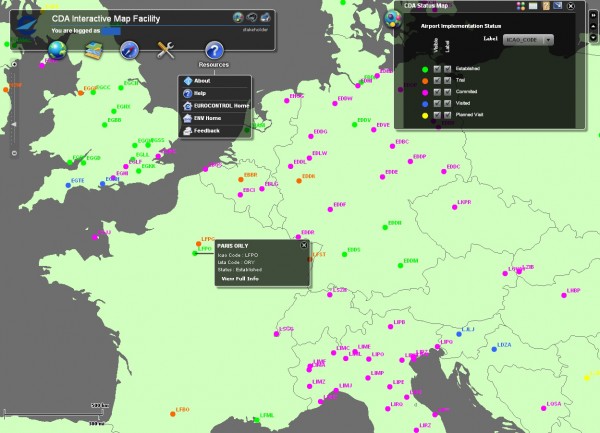Improving efficiency while helping the environment
- Like
- Digg
- Del
- Tumblr
- VKontakte
- Buffer
- Love This
- Odnoklassniki
- Meneame
- Blogger
- Amazon
- Yahoo Mail
- Gmail
- AOL
- Newsvine
- HackerNews
- Evernote
- MySpace
- Mail.ru
- Viadeo
- Line
- Comments
- Yummly
- SMS
- Viber
- Telegram
- Subscribe
- Skype
- Facebook Messenger
- Kakao
- LiveJournal
- Yammer
- Edgar
- Fintel
- Mix
- Instapaper
- Copy Link
Posted: 1 October 2010 | Eric Miart, Airport Programme and Environment Activity Manager, EUROCONTROL | No comments yet
The latest developments in Airport Collaborative Decision Making (A-CDM) and Continuous Descent Approaches (CDA)
If you work at a large airport, the chances are that you will be affected by at least one, if not both, of these initiatives. Implementation is rolling out across Europe. For CDA we are well on the way to 100 airports by 2013, while for A-CDM we expect eight airports by the end of next year.
The latest developments in Airport Collaborative Decision Making (A-CDM) and Continuous Descent Approaches (CDA)
If you work at a large airport, the chances are that you will be affected by at least one, if not both, of these initiatives. Implementation is rolling out across Europe. For CDA we are well on the way to 100 airports by 2013, while for A-CDM we expect eight airports by the end of next year.
So what are these initiatives and what practical benefits are they already yielding?
Collaborative Decision Making
Collaborative Decision Making does sound worryingly like “Management by Committee” – not generally a recommended method! However, it’s not that at all. Rather it means that all the players at an airport manage their own businesses but with a greater awareness and understanding of how their decisions affect their partners.
Airport CDM is about partners (airport operators, aircraft operators, ground handlers and air traffic control) working together more efficiently and transparently in how they work and share data. It means making better decisions – based on more accurate and timely information, with all airport partners having the same operational picture. For example, if an incoming flight from Delhi takes off two hours late, that has implications for everyone. Sharing this information automatically just makes good sense.
In part it’s a question of adapting operational procedures, changing processes and introducing user friendly tools. But there’s also the need for changing the culture to one of sharing information and working in partnership. Culture change doesn’t happen overnight! However, the benefits that we’ve already seen are a great help in the process of persuading more airports to make the change.
The aim is to reduce delays, to improve the predictability of events during a flight and to optimise the use of resources. This also has real benefits at a network level, with more accurate take-off information feeding into the Air Traffic Flow and Capacity Management (ATFCM) system. Indeed, the A-CDM concept is an integral part of the SESAR initiative.
At EUROCONTROL, our role is to facilitate the implementation of A-CDM at ECAC airports. We do this in collaboration with our stakeholders, such as ACI EUROPE and IATA. They are invaluable in helping to raise awareness and to open doors. We also provide training, both directly at EUROCONTROL’s Institute of Air Navigation Services (IANS) and through ‘train the trainer’ courses.
Last but not least, we work on standard – isation and on disseminating Airport CDM best practices across European airports. A major milestone occurred in June, when the A-CDM Community Specification was published in the EU Official Journal.
Implementation is now gathering pace. Although only two airports (Munich and Brussels-Zaventem) have fully implemented A-CDM, 31 others have started, of which six are expected to be operational by the end of 2011. Airports clearly on track to full implementation include Paris CDG, Heathrow, Schiphol, Frankfurt, Zurich, Prague, Gatwick, Lyon, Helsinki, Warsaw, Athens and Rhodes.
A-CDM brings shared advantages for the airport as a whole – for example from improved competitiveness. It also helps network performance. But just as importantly, each of the main partners at an airport realises benefits for themselves.
The airport operator sees environmental benefits such as less noise and lower CO2 emissions, as well as improved punctuality, more efficient gate planning and increased airport capacity. ATC has a reduced workload due to greater predictability of traffic, a smaller risk of errors, better order of departing aircraft and improved customer focus.
Airlines have shorter taxi and waiting times, resulting in fuel savings and lower emissions; they also have fewer delays resulting in greater passenger satisfaction and more fleet capacity. Handling agents see the ability to plan better and use their resources more efficiently, leading to lower costs and improved customer satisfaction.
So what are the results? Well, let’s look at Munich and compare 2005 (the last year without A-CDM) with 2009. Here are just a few of the quantified results:
◆ Slot adherence rose dramatically from 75.1% to 90.3%
◆ Waiting time at the runway fell from 4.39 minutes to 3.09 minutes
◆ Airlines are now saving €3.6M of fuel a year.
The network benefits are expected to increase rapidly as more and more airports implement A-CDM, giving Air Traffic Controllers more confidence in predictions. For example, with 16 airports we can expect:
◆ Sectors benefiting from improved traffic flows, better predictability and reduction of sector capacity buffers, while maintaining safety levels
◆ Better anticipation of adverse conditions and better management of the subsequent changes in capacity
◆ The possibility of allowing increases in the declared capacity of sectors.
With 42 airports, additional benefits will arise:
◆ A potential reduction of 18 to 23% of minutes of ATFM delays
◆ Up to 4 % overall network capacity improvement


Continuous DescentApproaches
The concept of CDAs has been around for a while and the benefits are clear. Descending smoothly and continuously from the cruise saves money and fuel and is less noisy. There have been numerous high profile ‘green’ flights demonstrating this.
What is trickier is the process of making CDAs part of the everyday flight patterns – especially at a busy airport. However, we can report real progress here.
A first step is to realise that there is no “one size fits all” solution. For example, CDAs can be based on “standard navigation” or on Performance Based Navigation (PBN) or P-RNAV; they can use Standard Arrival Routes (STARS) designed with CDA in mind, or even new techniques such as Point Merge.
Also, you need to be as pragmatic as possible, recognising that it is not possible for all flights at all airports to use CDA starting from the cruise. However, the aim has to be to promote and facilitate the widespread usage of CDA in as many airports as possible, for as many flights as possible and for the longest extent possible for each flight.
There is considerable support for this, as evidenced by the joint signing by EUROCONTROL, IATA and CANSO of the Flight Efficiency Plan in August 2008. One of the five action points in this Plan is to promote efficient TMA design and utilisation; a key part of that is the implementation of CDA. The Plan is complemented by a Memorandum of Understanding signed later that year by EUROCONTROL and ACI EUROPE, agreeing to work on a range of collaborative initiatives to improve efficiency at airports.
We are now well underway to achieve the target of implementation of CDA at 100 airports by 2013. The latest status is: ◆ 33 airports offer CDA at some point in the day
◆ 13 airports with CDA trials in progress
◆ 83 airports to investigate CDA feasibility.
Details of progress can be found on our recently launched interactive map (contact [email protected]).
CDA brings tangible benefits in terms of fuel burn, emissions and noise – all of which are clear priorities. On fuel burn, savings in trials have amounted to between 50 and 150kg – equating to between 160 and 470 kg of CO2. This will depend not only on the aircraft type but also on the level at which the CDA is commenced. However, even a relatively low level beginning of a CDA provides real savings.
Indeed, it is the latter stages of the flight which also bring the main benefits as regards noise – between 25 and 8NM from touchdown. Up to 5dBA SEL reduction could be measured over conventional approaches, with a significant reduction in the noise contour area.
Conclusion
A-CDM and CDA have several similarities – they are both practical initiatives that yield real benefits without large capital investment. That doesn’t mean that they are easy to achieve! But it does mean that they are very likely to make sound financial sense while being environmentally friendly.
The Emissions Trading Scheme (ETS) can only strengthen the case in favour of A-CDM and CDA. Find out more at www.euro-cdm.org and www.eurocontrol.int/environment
About the Author
Eric Miart
Eric Miart is the Airport Programme and Environment Activity Manager at EUROCONTROL. A qualified commercial pilot with a Masters degree in ATM and IT, he spent eight years as an Approach Air Traffic Controller at Charles de Gaulle, followed by a further 10 years ATM managerial experience at Orly before joining EUROCONTROL in 1994.
Issue
Related topics
Air traffic control/management (ATC/ATM), Airport Collaborative Decision Making (A-CDM), Sustainability


















